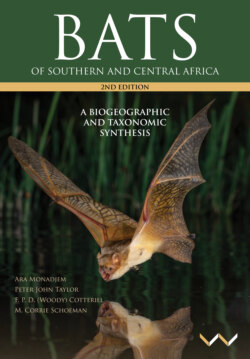Читать книгу Bats of Southern and Central Africa - Ara Monadjem - Страница 23
На сайте Литреса книга снята с продажи.
PREDATION
ОглавлениеAlthough the natural mortality of bats is high in their first year, it is remarkably low in subsequent years of life (Ransome 1995, Bernard and Cumming 1997, Monadjem et al. 2015). In Nycteris thebaica, about 34% of female and 43% of male juveniles survive through the first year, after which survival increases to about 60–70% per year (Monadjem et al. 2015). The survival rates of other southern African bat species are poorly known. Numerous animals hunt bats, including snakes, owls (Cotterill 1992), other birds of prey (Kemp and Rautenbach 1987, Thomsett 1987, Fenton et al. 1994, Fenton 1995), certain passerine birds, small carnivores such as genets and domestic cats, and humans. Some bats, for example Nycteris grandis of Central and southern Africa (Fenton et al. 1993), also eat other bats, while the bat hawk (Macheiramphus alcinus) is a specialised avian predator of bats (Hustler and Dean 2005).
